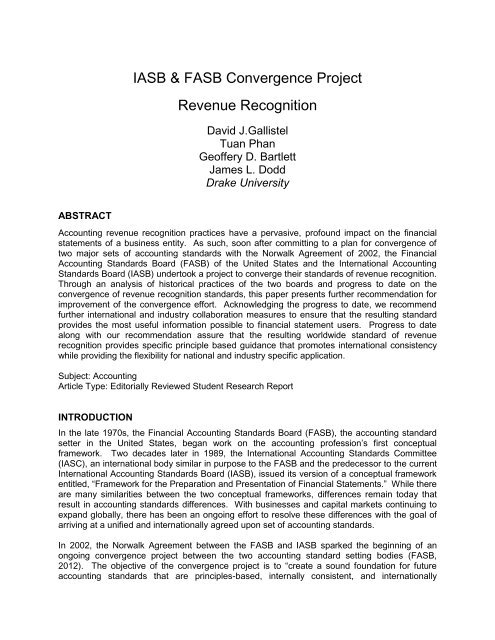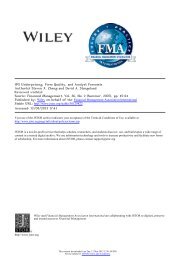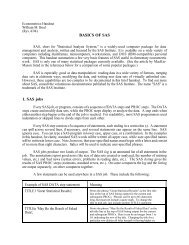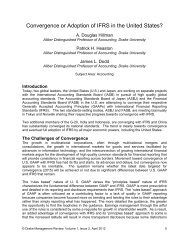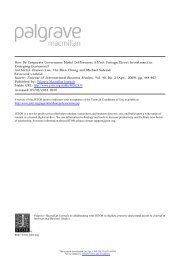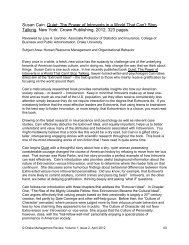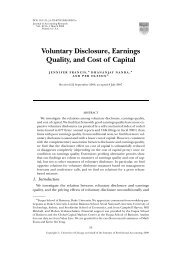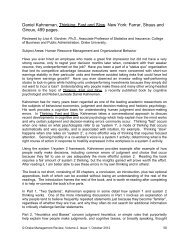IASB & FASB Convergence Project - Drake College of Business and ...
IASB & FASB Convergence Project - Drake College of Business and ...
IASB & FASB Convergence Project - Drake College of Business and ...
Create successful ePaper yourself
Turn your PDF publications into a flip-book with our unique Google optimized e-Paper software.
<strong>IASB</strong> & <strong>FASB</strong> <strong>Convergence</strong> <strong>Project</strong>Revenue RecognitionDavid J.GallistelTuan PhanGe<strong>of</strong>fery D. BartlettJames L. Dodd<strong>Drake</strong> UniversityABSTRACTAccounting revenue recognition practices have a pervasive, pr<strong>of</strong>ound impact on the financialstatements <strong>of</strong> a business entity. As such, soon after committing to a plan for convergence <strong>of</strong>two major sets <strong>of</strong> accounting st<strong>and</strong>ards with the Norwalk Agreement <strong>of</strong> 2002, the FinancialAccounting St<strong>and</strong>ards Board (<strong>FASB</strong>) <strong>of</strong> the United States <strong>and</strong> the International AccountingSt<strong>and</strong>ards Board (<strong>IASB</strong>) undertook a project to converge their st<strong>and</strong>ards <strong>of</strong> revenue recognition.Through an analysis <strong>of</strong> historical practices <strong>of</strong> the two boards <strong>and</strong> progress to date on theconvergence <strong>of</strong> revenue recognition st<strong>and</strong>ards, this paper presents further recommendation forimprovement <strong>of</strong> the convergence effort. Acknowledging the progress to date, we recommendfurther international <strong>and</strong> industry collaboration measures to ensure that the resulting st<strong>and</strong>ardprovides the most useful information possible to financial statement users. Progress to datealong with our recommendation assure that the resulting worldwide st<strong>and</strong>ard <strong>of</strong> revenuerecognition provides specific principle based guidance that promotes international consistencywhile providing the flexibility for national <strong>and</strong> industry specific application.Subject: AccountingArticle Type: Editorially Reviewed Student Research ReportINTRODUCTIONIn the late 1970s, the Financial Accounting St<strong>and</strong>ards Board (<strong>FASB</strong>), the accounting st<strong>and</strong>ardsetter in the United States, began work on the accounting pr<strong>of</strong>ession’s first conceptualframework. Two decades later in 1989, the International Accounting St<strong>and</strong>ards Committee(IASC), an international body similar in purpose to the <strong>FASB</strong> <strong>and</strong> the predecessor to the currentInternational Accounting St<strong>and</strong>ards Board (<strong>IASB</strong>), issued its version <strong>of</strong> a conceptual frameworkentitled, “Framework for the Preparation <strong>and</strong> Presentation <strong>of</strong> Financial Statements.” While thereare many similarities between the two conceptual frameworks, differences remain today thatresult in accounting st<strong>and</strong>ards differences. With businesses <strong>and</strong> capital markets continuing toexp<strong>and</strong> globally, there has been an ongoing effort to resolve these differences with the goal <strong>of</strong>arriving at a unified <strong>and</strong> internationally agreed upon set <strong>of</strong> accounting st<strong>and</strong>ards.In 2002, the Norwalk Agreement between the <strong>FASB</strong> <strong>and</strong> <strong>IASB</strong> sparked the beginning <strong>of</strong> anongoing convergence project between the two accounting st<strong>and</strong>ard setting bodies (<strong>FASB</strong>,2012). The objective <strong>of</strong> the convergence project is to “create a sound foundation for futureaccounting st<strong>and</strong>ards that are principles-based, internally consistent, <strong>and</strong> internationally
converged” (<strong>IASB</strong>, 2012). While the pace <strong>of</strong> convergence was initially slow, there has been arecent increase in momentum <strong>and</strong> an ambitious goal <strong>of</strong> full convergence by 2015 has been set(Defelice <strong>and</strong> Lamoreaux, 2010). With the targeted date for convergence quickly approaching,it is critical for businesses to have a full underst<strong>and</strong>ing <strong>of</strong> how the proposed new st<strong>and</strong>ards mayaffect their organizations.This paper focuses on one area critical to all organizations – revenue recognition. We firstexamine the motivation for converging the criteria that must be met in order for organizations t<strong>of</strong>ormally recognize revenue. To explore this area, we provide a timeline <strong>of</strong> events that led to thecurrent st<strong>and</strong>ards for revenue recognition for both the <strong>FASB</strong> <strong>and</strong> <strong>IASB</strong>. Next, we compare <strong>and</strong>contrast the similarities <strong>and</strong> differences in current revenue recognition st<strong>and</strong>ards whileexamining the various political environments, constraints, <strong>and</strong> pressures faced by the differentst<strong>and</strong>ard setters. We conclude by proposing a set <strong>of</strong> revenue recognition criteria thatincorporates both the <strong>FASB</strong> <strong>and</strong> <strong>IASB</strong> conceptual frameworks, but also considers economicfactors, technological advances, various emerging issues, <strong>and</strong> political pressures.BACKGROUNDRevenue recognition has been a critical topic <strong>of</strong> discussion <strong>and</strong> concern since the <strong>FASB</strong> beganwork on its conceptual framework. The first guidance provided to U.S. companies regarding theconditions that must be met in order for revenue to be recognized came from the <strong>FASB</strong> in 1984when it released its fifth Statement <strong>of</strong> Financial Accounting Concepts (SFAC No. 5). Thispronouncement defines two broad criteria that must be satisfied before companies canrecognize revenue. The first is that revenue must be realizable or realized (i.e., the organizationmust be able to reasonably estimate the probability that it will be paid). The second is that therevenue must be earned (i.e., the organization has substantially accomplished that which isrequired in order for the organization to be entitled to the benefits represented by the revenue).Despite the intentions <strong>of</strong> SFAC No. 5 to <strong>of</strong>fer clear principles regarding the recognition <strong>of</strong>revenue, the potential ambiguity implicit in these two criteria has led to numerous frauds overthe last three decades.According to a 1999 report issued by the Committee <strong>of</strong> Sponsoring Organizations (COSO),several frauds during the 1987-1997 time period were a result <strong>of</strong> overstatements <strong>of</strong> revenue,typically at the end <strong>of</strong> an accounting period in an effort to bolster earnings (COSO, 1999). The1999 COSO report finds that the second criterion <strong>of</strong> SFAC No. 5 was violated in several <strong>of</strong>these frauds involving revenue recognition, namely, the recognition <strong>of</strong> revenue prior to it actuallyhaving been earned. Since the issuance <strong>of</strong> the 1999 COSO report, there have been numerousadditional financial reporting frauds that have been attributed to violations <strong>of</strong> the spirit <strong>of</strong> SFACNo. 5. Consequently, the Securities <strong>and</strong> Exchange Commission (SEC), at times in concert withthe <strong>FASB</strong>, have provided additional guidance to companies regarding revenue recognition.Specifically, there have been at least six st<strong>and</strong>ards issued subsequent to SFAC No.5 dealingwith revenue recognition, with four specific areas being identified as potentially problematic: bill<strong>and</strong>-holdarrangements, long-term contract arrangements, barter advertising, <strong>and</strong> agentfacilitatorrelation transactions (Briner, 2001).For example, a bill-<strong>and</strong>-hold transaction involves a buyer purchasing merch<strong>and</strong>ise from a sellerwhile the seller retains physical custody <strong>of</strong> the merch<strong>and</strong>ise. To the extent the seller physicallyseparates the merch<strong>and</strong>ise from its active inventory, the seller is permitted to recognize therevenue on the sale. However, this type <strong>of</strong> transaction has been shown to have a potentiallyhigh risk for fraud. Specifically, a seller can set merch<strong>and</strong>ise inventory aside <strong>and</strong> claim it has© <strong>Drake</strong> Management Review, Volume 2, Issue 1, October 2012 37
een sold to a customer while falsifying purchase orders. Moreover, the SEC has banned theability <strong>of</strong> companies to recognize revenue in bill-<strong>and</strong>-hold transactions when only a verbalagreement to purchase merch<strong>and</strong>ise exits between parties (Briner, 2001).A recent example involving Groupon illustrates the potential problems inherent in agentfacilitatortransactions. In these types <strong>of</strong> transactions, the agent retains custody <strong>of</strong> theinventory, but does not have ownership rights to it. Therefore, upon the sale <strong>of</strong> the inventory,the agent should only recognize the commission on the sale, not the entire value <strong>of</strong> the sale.Shortly after its initial public <strong>of</strong>fering on November 4, 2011, Groupon’s revenue recognitionpractices came under scrutiny. Specifically, it was found that Groupon was recording thecommission on the sale <strong>of</strong> coupons <strong>and</strong> the coupons being sold as revenue. Consequently,Groupon was forced to restate earnings for its first three months as a publicly listed company,which reduced revenue from 713.4 million to 312.9 million, or a decrease <strong>of</strong> 56.1-percent(McMillan, 2011).With ever-increasing competition <strong>and</strong> pressure for companies to release favorable earningsreports, along with the potential for fraud that exists due to the ambiguity in the current revenuerecognition guidance, it has become increasingly critical for the <strong>FASB</strong> <strong>and</strong> <strong>IASB</strong> to establish aunified set <strong>of</strong> accounting st<strong>and</strong>ards. In January 2002, the <strong>FASB</strong> began discussions on a majorproject to overhaul the existing revenue recognition st<strong>and</strong>ards (<strong>FASB</strong>, 2012). Thesediscussions began identifying the objectives <strong>and</strong> scope <strong>of</strong> the project, which would result incomprehensive guidelines for the recognition <strong>of</strong> revenue in various industries. While the projectwould involve amending current SFACs, it would also provide new guidance. In June 2002, the<strong>IASB</strong> added revenue recognition to its technical agenda. The <strong>FASB</strong> <strong>and</strong> <strong>IASB</strong> entered into aformal agreement in September 2002 to work jointly on the revenue recognition project <strong>and</strong> toshare staff resources. The objectives <strong>of</strong> the joint project were as follows:1. Remove inconsistencies <strong>and</strong> weaknesses in existing revenue requirements.2. Provide a more robust framework for addressing revenue issues.3. Improve comparability <strong>of</strong> revenue recognition practices across entities, industries,jurisdictions, <strong>and</strong> capital markets.4. Provide more useful information to users <strong>of</strong> financial statements through improveddisclosure requirements.5. Simplify the preparation <strong>of</strong> financial statements by reducing the number <strong>of</strong> requirementsto which an entity must refer. (<strong>FASB</strong>, 2012)The project began by simultaneously taking two interrelated approaches. Using a “top-down”approach, staff members developed conceptual guidance for the recognition <strong>and</strong> measurement<strong>of</strong> revenues. The aim <strong>of</strong> this approach was to establish the conceptual “back bone” <strong>of</strong> the newst<strong>and</strong>ard. Using a “bottom-up” approach, staff members analyzed the existing authoritativeguidance <strong>of</strong> both the <strong>FASB</strong> <strong>and</strong> <strong>IASB</strong> regarding revenue recognition principles <strong>and</strong> practices.The objective <strong>of</strong> this approach was to identify which principles were “working” <strong>and</strong>, therefore,should be retained in the new st<strong>and</strong>ard.Prior to May 2005, the Boards were developing a revenue recognition model that wouldmeasure assets <strong>and</strong> liabilities at fair values (the so-called "fair value" or "measurement" model).Under this approach, the Boards tentatively agreed that performance obligations should bemeasured at fair value—that is, the price that the reporting entity would have to pay anunrelated party to assume legal responsibility for performing all <strong>of</strong> its remaining obligations.However, some Board members expressed concerns regarding the reasonableness <strong>of</strong>estimating non-observable prices (as is common in practice). Further, there were concerns© <strong>Drake</strong> Management Review, Volume 2, Issue 1, October 2012 38
egarding the pattern <strong>of</strong> revenue recognition under such a model. In light <strong>of</strong> these concerns, theBoards explored an alternative model—the customer consideration model. Under this model,performance obligations would be measured at an allocated customer consideration (i.e.,transaction price) amount. After several years <strong>of</strong> working together, the Boards issued aDiscussion Paper, Revenue Recognition in Contracts with Customers, in December 2008 thatfollowed the allocated customer consideration approach.INTERNATIONAL ACCOUNTING STANDARDS BOARDTo better underst<strong>and</strong> <strong>IASB</strong> revenue recognition practices prior to convergence efforts, it isimportant to have an underst<strong>and</strong>ing <strong>of</strong> the Framework for the Preparation <strong>and</strong> Presentation <strong>of</strong>Financial Statements. This document is the conceptual framework that was formally adopted bythe <strong>IASB</strong> in 2001. Rather than explicitly defining revenue, this framework defines <strong>and</strong> discussesthe term “income,” which can include revenues <strong>and</strong> gains. In the context <strong>of</strong> this paper, it isimportant to distinguish between revenues <strong>and</strong> gains as they have different meanings.Revenue, which is the focus <strong>of</strong> this paper, results from the ordinary operations <strong>and</strong> activities <strong>of</strong>an organization <strong>and</strong> include, but are not limited to: sales, fees, interest, dividends, royalties, <strong>and</strong>rent (<strong>IASB</strong>, 2010). Gains on the other h<strong>and</strong> are defined as “an increase in economic benefits”(<strong>IASB</strong>, 2010). The current <strong>IASB</strong> Conceptual Framework still considers gains <strong>and</strong> benefits toultimately be similar in nature <strong>and</strong> will continue to be addressed under the term income.Under the initial <strong>IASB</strong> Conceptual Framework, companies were to recognize revenue based ontwo general assumptions. The first was that it would be probable that any future economicbenefit associated with the sale <strong>of</strong> an item would flow to the organization. This assumption,which has remained unchanged, deals with the degree <strong>of</strong> uncertainty that the benefits willactually flow to the company. The assumption <strong>and</strong> the assessment <strong>of</strong> the uncertainty are to beuniquely based on the evidence available when the financial statements are being prepared.The second assumption is that the cost or value <strong>of</strong> the item being sold can be measured withreliability. Under these two assumptions, income is to be recognized “…when an increase infuture economic benefits related to an increase in an asset or a decrease <strong>of</strong> a liability has arisenthat can be measured reliably”(<strong>IASB</strong> 2001).The second assumption mentioned above explicitly deals with valuation <strong>of</strong> revenue. Under the<strong>IASB</strong>’s Conceptual Framework <strong>and</strong> International Accounting St<strong>and</strong>ard No. 18 (discussedbelow), revenue is to be measured at the fair value <strong>of</strong> the received or receivable (IAS 18, 2001).The fair value is defined as the agreed upon price (if the entities are using currency) betweenthe seller <strong>and</strong> buyer, net <strong>of</strong> any discounts or rebates allowed by the seller. If the fair value <strong>of</strong> thegoods or services cannot be readily measured by fair market value, companies must measure itby the value or the cost <strong>of</strong> the services provided. In circumstances where a fair value or costcannot be determined, the item cannot be included in the balance sheet or income statement.To the extent the item is material in nature, companies are required to disclose the item in thefootnotes to the financial statements, along with any supplementary information/data (<strong>IASB</strong>,2012).In 2001, the <strong>IASB</strong> released IAS No. 18, which is titled “Revenue.” This st<strong>and</strong>ard supersedesIAS No. 18 “Revenue Recognition,” which was issued in December 1982. This st<strong>and</strong>ardaddresses revenues resulting from the sale <strong>of</strong> goods, the rendering <strong>of</strong> services, <strong>and</strong>/or the useby others <strong>of</strong> entity assets yielding interest, royalties, <strong>and</strong> dividends (<strong>IASB</strong> 2001). While the twobasic assumptions listed above are still applicable, this st<strong>and</strong>ard <strong>of</strong>fers additional guidance© <strong>Drake</strong> Management Review, Volume 2, Issue 1, October 2012 39
ased on the type <strong>of</strong> revenue being recognized. For example, with respect to the sale <strong>of</strong> goods,an entity can recognize revenue when all <strong>of</strong> following criteria are satisfied:1. The entity has transferred to the buyer the significant risks <strong>and</strong> rewards <strong>of</strong> ownership <strong>of</strong>the merch<strong>and</strong>ise/goods/item.2. The selling entity will no longer have a controlling ability over the good(s) or continuingmanagerial involvement.3. The amount <strong>of</strong> revenue can be measured reliably.4. It is probable that benefits will flow to the entity.5. Cost <strong>of</strong> the transaction can be measured reliably.In the majority <strong>of</strong> cases, the first requirement is satisfied when the title <strong>of</strong> the goods has beentransferred to the buyer <strong>and</strong> the buyer gains physical custody <strong>of</strong> the item(s). However, insituations such as overseas sales, the transfer <strong>of</strong> ownership does not necessarily mean thatthey buyer has physical custody <strong>of</strong> the good(s). In these circumstances the first requirementcannot be satisfied unless a) the sales contract states that the good(s) will transfer ownershipwhen the merch<strong>and</strong>ise has passed a certain checkpoint during the shipping/h<strong>and</strong>ling process<strong>and</strong> b) the merch<strong>and</strong>ise passes that predetermined checkpoint.The second requirement is relatively straightforward. However, it should be noted that post-salemaintenance <strong>and</strong>/or minor contractual obligations are not considered to constitute a “controllingability” or “managerial involvement.” To the extent that, based on previous experience <strong>and</strong>/orother relevant factors, sellers can reasonably estimate expected maintenance/service costs orthe possibility <strong>of</strong> returns, sellers can recognize the revenue (<strong>IASB</strong>, IAS No. 18, 2001). The third<strong>and</strong> fourth requirements flow from the initial <strong>IASB</strong> Conceptual Framework <strong>and</strong> are applied in amanner similar to that mentioned above.For the fifth requirement to be satisfied, any expense(s) related to the sales transaction must berecognized when the associated revenue is recognized. In circumstances when a salestransaction is accompanied by a warranty, the associated expense must be recognized at thetime <strong>of</strong> sale, assuming there is a reliable method <strong>of</strong> measuring the expense (e.g., pastexperience). If the expense associated with the warranty cannot be reliably measured, therevenue cannot be recognized, but rather must be converted to a liability (<strong>IASB</strong>, IAS No. 18,2001).Revenue recognition for certain servicing industries follows a method referred to as the“percentage <strong>of</strong> completion” method. While the two basic revenue recognition principles <strong>of</strong> the<strong>IASB</strong> Conceptual Framework are still applicable, it is also required that a) the cost up until thepoint <strong>of</strong> reporting <strong>and</strong> b) the cost to complete the service are measurable <strong>and</strong> that themeasurement method is reliable. The industries most affected by these latter two requirementsare the construction <strong>and</strong> repair industries. Given that significant construction contracts <strong>of</strong>tenextend beyond a particular reporting time horizon, it would be inappropriate to defer all revenuesfrom the contract until the construction is fully completed. It would also be inappropriate torecognize all revenues from the contract in advance <strong>of</strong> fully construction completion. Therefore,the “percentage <strong>of</strong> completion” approach is allowed under these circumstances. According toIAS No. 11 “Construction Contracts,” the contract revenue shall comprise:1. The initial amount <strong>of</strong> revenue agreed upon in the contract; <strong>and</strong>2. Variations in contract work, claims, <strong>and</strong> incentives:a. to the extent that it is probable that they will result in revenue; <strong>and</strong>© <strong>Drake</strong> Management Review, Volume 2, Issue 1, October 2012 40
. They are capable <strong>of</strong> being reliably measured.A company can make reliable estimates after both parties have reached an agreement. Theagreement must define obligations <strong>and</strong> rights to the asset for each party <strong>and</strong> the conditions <strong>and</strong>terms <strong>of</strong> the job.One major difference between construction revenues <strong>and</strong> other types <strong>of</strong> revenues is theconstant re-measurement <strong>of</strong> contract revenue inherent in construction contracts. For example,revenue for a five-year construction contract is likely to fluctuate from year-to-year. Majorcauses <strong>of</strong> these variations can include unexpected costs, cost escalation due to an agreementin the contract, penalty costs, <strong>and</strong> unforeseen additional work. Further, construction customersmay desire to alter a section <strong>of</strong> the contract, which could lead to an expansion or reduction <strong>of</strong>the initial contract. In circumstances in which a customer wishes to exp<strong>and</strong> the extent <strong>of</strong> workbeing performed, the company must recalculate revenues <strong>and</strong> expenses. The additionalrevenue can be recognized when a) the customer approves the revisions to the contract <strong>and</strong> b)the amount <strong>of</strong> additional revenue can be reliably measured.Other forms <strong>of</strong> income resulting from construction contracts (e.g., claims or bonuses) havespecific requirements that must be met before revenue can be recognized. A claim is definedas an attempt <strong>of</strong> the contractor to recoup costs that extended beyond the scope <strong>of</strong> the contract.These costs could result from carless mistakes caused by customers, errors, <strong>and</strong> contestablecosts. Given that these costs are frequently beyond the scope <strong>of</strong> the contract, the level <strong>of</strong>uncertainty regarding their amounts is considered relatively high. Therefore, this type <strong>of</strong> incomemust meet the requirement that “negotiations have reached an advanced stage such that it isprobable that the customer will accept [or pay] for the claim,” <strong>and</strong> the amount being accepted orpaid can be reliably measured (<strong>IASB</strong>, IAS No. 11, 2001). Bonuses have similar requirements.Specifically, if it is reasonably foreseeable that that the contractor’s performance will satisfybonus requirements, the resulting bonus revenue can be recognized given that it can be reliablymeasured.With respect to interest, dividends <strong>and</strong> royalties, the same two basic criteria listed in the <strong>IASB</strong>Conceptual Framework must be satisfied prior to revenue being recognized. In addition, thefollowing guidance is <strong>of</strong>fered by the revised st<strong>and</strong>ard:1. Interest shall be recognized using the effective interest method.2. Dividends shall be recognized when the shareholder’s right to receive payment isestablished.3. Royalties shall be recognized on the accrual basis in accordance with the substance <strong>of</strong>the relevant agreement.The first requirement states that the effective interest method must be used when recognizinginterest revenue. Specifically, an effective interest rate must be used to calculate earnings. Thedefinition <strong>of</strong> this term refers to the method <strong>of</strong> calculating amortization cost <strong>and</strong> the allocation <strong>of</strong>interest income/expense over a period <strong>of</strong> time (<strong>IASB</strong>, IAS No. 39, 2001). An acceptableeffective interest rate will discount the financial instruments to their present value. Additionally,all other aspects, expenses, <strong>and</strong> income <strong>of</strong> the financial instrument must be considered. Incircumstances where the collectability <strong>of</strong> interest revenue is no longer expected or cannot beguaranteed, the estimated uncollectable amount is to be converted to an expense.© <strong>Drake</strong> Management Review, Volume 2, Issue 1, October 2012 41
FINANCIAL ACCOUNTING STANDARDS BOARDUnder United States Generally Accepted Accounting Principles, revenue recognition hasgenerally been determined based on the meeting <strong>of</strong> two major criteria, prospective revenue isrealized or realizable <strong>and</strong> such prospective revenue is earned. The rationale for the <strong>FASB</strong>’sguidance on revenue recognition is predicated on the income statement focus <strong>of</strong> financialreporting in the United States. This income statement focus can be seen in the <strong>FASB</strong>’s heavyreliance on the completion <strong>of</strong> the earning process for recognition <strong>of</strong> revenue. In addition tomeeting these two basic criteria, the U.S. Securities <strong>and</strong> Exchange Commission in its StaffAccounting Bulletin No. 101 states that revenue recognition criteria are met when the followingfour events have occurred:1) Persuasive evidence <strong>of</strong> an arrangement exists.2) Delivery has occurred or services have been rendered.3) The seller’s price to the buyer is fixed or determinable.4) Collectibility is reasonably assured. (Briner, 2001)The <strong>of</strong>ten-ambiguous nature <strong>of</strong> the timing <strong>of</strong> these four events adds significant complexity to thebasic determination <strong>of</strong> recognizing revenue, that being revenue is recognized when a sale takesplace.As specific industries <strong>and</strong> obscure transactions add additional complexity to the alreadycomplex issue <strong>of</strong> revenue recognition, the remainder <strong>of</strong> this section is concerned with precodification/pre-convergenceU.S. GAAP related to the most common issues in revenuerecognition corresponding with the topics discussed from IAS 18 in the previous section. <strong>FASB</strong>guidance will be cited in relation to sales <strong>of</strong> goods, sales <strong>of</strong> services, interest, royalties, <strong>and</strong>dividends. Providing the historical U.S. GAAP <strong>and</strong> <strong>FASB</strong> guidance in relation to these mattersprovides a foundation for comparison between IFRS <strong>and</strong> U.S. GAAP as well as a baseline forcurrent <strong>and</strong> continued convergence between the two sets <strong>of</strong> st<strong>and</strong>ards, which is discussed laterin this paper.The sales <strong>of</strong> goods <strong>and</strong> services are generally closely related. Statement <strong>of</strong> FinancialAccounting Concepts (SFAC) No. 5 paragraphs 83 <strong>and</strong> 84 provide guidance as to therecognition <strong>of</strong> revenue from these sources. Paragraph 83(b) <strong>of</strong> SFAC No. 5 states, "an entity'srevenue-earning activities involve delivering or producing goods, rendering services, or otheractivities that constitute its ongoing major or central operations, <strong>and</strong> revenues are considered tohave been earned when the entity has substantially accomplished what it must do to be entitledto the benefits represented by the revenues.” Paragraph 84(a) sets forth the two generalcondition <strong>of</strong> revenue recognition, revenue being realized or realizable <strong>and</strong> that revenue beearned by stating that they “are usually met by the time product or merch<strong>and</strong>ise is delivered orservices are rendered to customers, <strong>and</strong> revenues from manufacturing <strong>and</strong> selling activities <strong>and</strong>gains <strong>and</strong> losses from sales <strong>of</strong> other assets are commonly recognized at time <strong>of</strong> sale (usuallymeaning delivery)." (U.S. Securities <strong>and</strong> Exchange Commission, 1999)While the preceding citations <strong>of</strong> SFAC No. 5 provide guidance on the most commontransactions involving the sale <strong>of</strong> goods <strong>and</strong> services, special circumstances do exist <strong>and</strong> arerecognized in the concept statement. In circumstances where the sale <strong>and</strong>/or cash receiptoccurs before production <strong>and</strong> delivery <strong>FASB</strong> guidance in SFAC No. 5 states that revenue is tobe recognized as production <strong>and</strong> delivery occur, such as in production <strong>and</strong> delivery <strong>of</strong> magazinesubscriptions. In such a situation, revenue has typically been realized in the form <strong>of</strong> an upfrontsubscription payment by the customer meeting the first criteria <strong>of</strong> revenue recognition.However, revenue is not earned until the periodic delivery <strong>of</strong> magazine issues; therefore, the© <strong>Drake</strong> Management Review, Volume 2, Issue 1, October 2012 42
second criteria for revenue recognition necessitates a deferral <strong>of</strong> revenue recognition. (FinancialAccounting St<strong>and</strong>ards Board (<strong>FASB</strong>)1, 2008)Issues <strong>of</strong> revenue recognition timing also occur in the case <strong>of</strong> construction contracts whereproduction occurs over an extended period <strong>of</strong> time <strong>and</strong> payment is not received until completion.In such situations guidance in SFAC No. 5 suggests that the percentage <strong>of</strong> completion methodbe used where reasonable estimates <strong>of</strong> results at completion <strong>and</strong> reliable measures <strong>of</strong> progressare available. (Financial Accounting St<strong>and</strong>ards Board (<strong>FASB</strong>)1, 2008)Revenue recognition is further complicated for the sale <strong>of</strong> goods where the buyer retains theright to return the subject matter <strong>of</strong> the sale. <strong>FASB</strong> provides authoritative guidance on thematter in Statement <strong>of</strong> Financial Accounting St<strong>and</strong>ards No. 48, Revenue Recognition WhenRight <strong>of</strong> Return Exists. When the buyer retains the right <strong>of</strong> return, SFAS No. 48 states thatrevenue can be recognized at the time <strong>of</strong> the sale if six criteria are met:1) The seller’s price to the buyer is substantially fixed or determinable at the date <strong>of</strong> sale.2) The buyer has paid the seller, or the buyer is obligated to pay the seller <strong>and</strong> theobligation is not contingent on resale <strong>of</strong> the product.3) The buyer’s obligation to the seller would not be changed in the event <strong>of</strong> theft or physicaldestruction or damage <strong>of</strong> the product.4) The buyer acquiring the product for resale has economic substance apart from thatprovided by the seller.5) The seller does not have significant obligations for future performance to directly bringabout resale <strong>of</strong> the product by the buyer.6) The amount <strong>of</strong> future returns can be reasonably estimated.(Financial Accounting St<strong>and</strong>ards Board (<strong>FASB</strong>) 2 , 2008)These criteria apply to most retail sales situations as well as most arrangements betweenmanufacturer-wholesaler-retailer. If any <strong>of</strong> the six criteria are not met, revenue may berecognized either when the return privilege has substantially expired or if those conditionssubsequently are met, whichever occurs first. (Financial Accounting St<strong>and</strong>ards Board (<strong>FASB</strong>)2,2008)When accounting for interest revenue, SFAC No. 5 in paragraph 84(d) provides generalguidance. In providing guidance the <strong>FASB</strong> states, “If services are rendered or rights to useassets extend continuously over time (for example, interest or rent), reliable measures based oncontractual prices established in advance are commonly available, <strong>and</strong> revenues may berecognized as earned as time passes.” (Financial Accounting St<strong>and</strong>ards Board (<strong>FASB</strong>)1, 2008)Specifically, authoritative guidance is provided for financial institutions in SFAS No.91,Accounting for Nonrefundable Fees <strong>and</strong> Costs Associated with Originating or Acquiring Loans<strong>and</strong> Initial Direct Costs <strong>of</strong> Lease, which requires interest revenue recognition treatment forcommitment <strong>and</strong> loan origination fees.Given the nature <strong>of</strong> a royalty agreement, in general terms, revenue recognition would be treatedsubstantially in accordance with the guidance provided by SFAC No. 5 in relation to interest orrents, as all grant one party the use <strong>of</strong> another party’s property for a predefined fee. In thisregard, revenues for royalties are generally recognized per their contract agreement. SFAS No.50, Financial Reporting in the Record <strong>and</strong> Music Industry <strong>and</strong> SFAS No. 53, Financial Reportingby Producers <strong>and</strong> Distributors <strong>of</strong> Motion Picture Films, which was superseded by SFAS No.139, provide authoritative guidance. SFAS No. 50 specifically addresses revenue recognitionwhen copyrighted material is essentially sold in its entirety where revenue is advised to berecorded when the earning process is complete <strong>and</strong> collection is reasonably assured. Also© <strong>Drake</strong> Management Review, Volume 2, Issue 1, October 2012 43
addressed is the licensor receiving a minimum guarantee from the licensee where the licensoris required to record the prospective revenue as a liability consistent with the concept <strong>of</strong>unearned revenue. (Financial Accounting St<strong>and</strong>ards Board (<strong>FASB</strong>)3, 2008)Dividend income is recognized under essentially the same guidance as most other revenue,when it is realized or realizable <strong>and</strong> earned. However, timing is the key to the guidanceprovided on recognition <strong>of</strong> dividend revenue recognition. Current codification under <strong>FASB</strong>section 946-320-25-4, Financial Services - Investment Companies, Investments - Debt <strong>and</strong>Equity Securities, Recognition, states that revenue recognition for the recipient <strong>of</strong> dividendincome is to be deferred until the “ex-dividend” date. (<strong>FASB</strong> Accounting St<strong>and</strong>ards Codification,2012) As the timing <strong>of</strong> revenue recognition has major tax implications, the IRS defines the exdividenddate as, "the first date following the declaration <strong>of</strong> a dividend on which the buyer <strong>of</strong> astock is not entitled to receive the next dividend payment." The ex-dividend date essentiallydefines when the earning process begins <strong>and</strong> ends for the holder <strong>of</strong> a dividend paying security<strong>and</strong>, therefore, also defines the date upon which the holder can recognize such revenue.While the basic tenets <strong>of</strong> revenue recognition under the <strong>FASB</strong>’s guidance have been followedfor decades, problems exist. U.S. GAAP contains no general st<strong>and</strong>ard for revenue recognition.Rather, the <strong>FASB</strong> provides in its conceptual framework general guidance on the matter.Beyond the conceptual framework, U.S. GAAP contains (pre-codification) more than a hundredst<strong>and</strong>ards on revenue recognition. The combination <strong>of</strong> lack a general authoritative st<strong>and</strong>ard <strong>and</strong>over a hundred special application st<strong>and</strong>ards can lead to inconsistency in revenue recognitionbetween similar firms. Inconsistent interpretation <strong>and</strong> application <strong>of</strong> the earnings process canalso lead to misrepresentation, either intentionally or unintentionally, <strong>of</strong> a company’s rights <strong>and</strong>obligations. (Bohusova, H., & Nerudova, D. 2009)A step in the direction <strong>of</strong> simplification <strong>of</strong> U.S. accounting st<strong>and</strong>ards came with the completion <strong>of</strong>the <strong>FASB</strong>’s codification project. <strong>FASB</strong> <strong>of</strong>ficially adopted the codification <strong>of</strong> U.S. GAAP on July1, 2009. The codification project did not change GAAP, but simplified the way in whichaccounting pr<strong>of</strong>essionals search the st<strong>and</strong>ards for guidance. Instead <strong>of</strong> navigating the complexseries <strong>of</strong> st<strong>and</strong>ards, pronouncements, opinions, <strong>and</strong> bulletins in search <strong>of</strong> guidance onaccounting issues, the codification has set up a searchable database organized by topic. As aresult, the preceding guidance has been superseded by <strong>FASB</strong> Accounting St<strong>and</strong>ardsCodification Topic 105, Generally Accepted Accounting Principles. (<strong>FASB</strong>, 2012) Simplification<strong>of</strong> United States accounting st<strong>and</strong>ards took on added importance with the decision <strong>of</strong> theFinancial Accounting St<strong>and</strong>ards Board <strong>and</strong> International Accounting St<strong>and</strong>ards Board to embarkon a convergence project to more closely align worldwide accounting st<strong>and</strong>ards. Currentprogress <strong>of</strong> this effort <strong>and</strong> recommendations for continued alignment in the area <strong>of</strong> revenuerecognition will be discussed later in this paper.ANALYSISThere are many similarities <strong>and</strong> differences when comparing revenue recognition criteria <strong>of</strong>IFRS <strong>and</strong> US GAAP. The similarities <strong>and</strong> differences are as follows:Measurement Criteria – both IFRS <strong>and</strong> US GAAP use the notion <strong>of</strong> fair value to measurerevenue. Both have similar criteria when it comes to an exchange <strong>of</strong> non-monetary exchanges.<strong>FASB</strong> states that the revenue for these exchanges would be measured at the fair value <strong>of</strong>goods or services surrendered. <strong>IASB</strong> measures the fair value <strong>of</strong> the item received. If a fair valueis not available, the entity receiving the item would use the fair value <strong>of</strong> the asset relinquished.© <strong>Drake</strong> Management Review, Volume 2, Issue 1, October 2012 44
When one goes deeper into the definition <strong>of</strong> fair value, this is where the two accounting bodiesdiverge. <strong>FASB</strong> defines fair value as the price that would be received to sell the asset or paid totransfer the liability in an orderly transaction between market participants at measurement date,an exit price approach. <strong>IASB</strong> defines fair value as the amount for which an asset could beexchanged, or a liability settled, between knowledgeable, willing parties in an arm’s lengthtransaction (<strong>IASB</strong>, IAS No. 18, 2001).The major difference in this definition can be argued for the clause “liability settled”. Some <strong>FASB</strong>board members argue this method <strong>of</strong> measurement would not be a fair value approach. Thisapproach would be considered “entry value” instead <strong>of</strong> “exit value”.Recognition criteria – <strong>FASB</strong> states that revenue can be recognized when it is realized orrealizable <strong>and</strong> must be earned. <strong>IASB</strong> created criteria that are quite different. Users <strong>of</strong> IFRS canrecognize revenue when it is probable that future economic benefits will flow to the enterprise,<strong>and</strong> it can be measured reliably.Revenue definition – extracted from SFAS no.5, <strong>FASB</strong> st<strong>and</strong>ards requires actual or expectedcash inflows that have occurred or will result from the entity’s ongoing major operation. IFRSst<strong>and</strong>ards define revenue as gross inflow <strong>of</strong> economic benefits during the period arising in thecourse <strong>of</strong> ordinary activities <strong>of</strong> an entity.Sale <strong>of</strong> goods – both entities define that revenue from a sales type transaction can berecognized when the goods have been delivered, risks <strong>and</strong> rewards are transferred,collectability is reasonably assured <strong>and</strong> measurement is reliable.Contract revenue recognition – <strong>FASB</strong> <strong>and</strong> <strong>IASB</strong> both use the percentage <strong>of</strong> completionapproach to recognize revenue when there is a reasonable estimate <strong>of</strong> revenues <strong>and</strong> costs.The difference in this category lies within the instances where the transaction cannot bereasonably estimated. <strong>FASB</strong> uses the completed contract method where <strong>IASB</strong> uses the zeropr<strong>of</strong>it method. The zero pr<strong>of</strong>it method assumes a break even approach to the contract when areasonable estimate cannot be obtained. Users <strong>of</strong> this method can revise the revenues <strong>and</strong>expenses when the contract is closer to the completion stage.<strong>FASB</strong> uses multiple st<strong>and</strong>ards to guide revenue recognition for different industry types, whereas<strong>IASB</strong> only published two st<strong>and</strong>ards to address the same subject. This difference can beattributed to the fundamental differences in how <strong>FASB</strong> <strong>and</strong> <strong>IASB</strong> establish st<strong>and</strong>ards. <strong>FASB</strong>approaches accounting st<strong>and</strong>ards in a more rules-based approach while <strong>IASB</strong> uses a broaderprinciples-based one.It is underst<strong>and</strong>able why <strong>IASB</strong> tends to use a principles-based approach. <strong>IASB</strong> st<strong>and</strong>ards guideaccounting practice for 100+ countries; therefore, detailed rules with multiple exceptions wouldbe necessary to accommodate the various cultures in multiple IFRS adopters. Broaderst<strong>and</strong>ards rely on pr<strong>of</strong>essional judgment <strong>of</strong> the accounting practitioners to comply with the spirit<strong>of</strong> the st<strong>and</strong>ards.RECOMMENDATION FOR CONVERGENCEIn September <strong>of</strong> 2002 the Financial Accounting St<strong>and</strong>ards Board <strong>and</strong> the InternationalAccounting St<strong>and</strong>ards Board signed the Norwalk Agreement, which proclaimed their intentionsto eliminate differences between U.S. GAAP <strong>and</strong> International Financial Reporting St<strong>and</strong>ards<strong>and</strong> to develop one set <strong>of</strong> high quality global accounting st<strong>and</strong>ards. (James, 2009) Due to itspervasive <strong>and</strong> dramatic impact on the financial statements <strong>of</strong> firms worldwide, one <strong>of</strong> the© <strong>Drake</strong> Management Review, Volume 2, Issue 1, October 2012 45
specific issues to first be addressed was that <strong>of</strong> revenue recognition. One month after theadoption <strong>of</strong> the Norwalk Agreement the <strong>IASB</strong> <strong>and</strong> <strong>FASB</strong> issued a memor<strong>and</strong>um <strong>of</strong>underst<strong>and</strong>ing, which was reaffirmed <strong>and</strong> updated in February <strong>of</strong> 2006 <strong>and</strong> included an initiativefor a joint project on revenue recognition. (Bohusova, H., & Nerudova, D. 2009)<strong>Convergence</strong> <strong>of</strong> revenue recognition st<strong>and</strong>ards between the two boards is a massiveundertaking. As discussed previously in this paper, IFRS contains two revenue recognitionst<strong>and</strong>ards, IAS 11 <strong>and</strong> IAS 18. While this is less cumbersome than the more than one hundredrevenue recognition st<strong>and</strong>ards in U.S. GAAP, inconsistencies between the principles <strong>of</strong> the twost<strong>and</strong>ards have been noted, which makes them difficult to apply beyond simple transactions.(Bohusova, H., & Nerudova, D. 2009) Our previous discussion <strong>of</strong> revenue recognition underU.S. GAAP touched on only a h<strong>and</strong>ful <strong>of</strong> basic revenue recognition principles correspondingmostly to those <strong>of</strong> IAS 18. U.S. GAAP contains upwards <strong>of</strong> 100 industry-specific st<strong>and</strong>ards, themultitude <strong>of</strong> which can lead to different recognition by different firms given similar transactions.Significant challenges face the two boards in adopting a joint st<strong>and</strong>ard on revenue recognition.Since their inception, IFRSs have been issued as general guidance <strong>of</strong> basic accountingprinciples, lacking specific guidance on a transaction level. U.S. GAAP on the other h<strong>and</strong>consists <strong>of</strong> specific rules <strong>and</strong> transaction level guidance on many issues that IFRSs leave tointerpretation. A second major issue lies in the difference between the two boards’ definition <strong>of</strong>what gives rise to revenue. As previously discussed, IFRS recognizes revenue based on therights <strong>and</strong> obligations or probable future benefits that can be reliably measured. Therefore, thefocus <strong>of</strong> IFRS is the determination <strong>of</strong> when a transaction creates an effect on the balance sheet.U.S. GAAP on the other h<strong>and</strong> is concerned with the measurement <strong>of</strong> revenue in <strong>and</strong> <strong>of</strong> itself.Under the <strong>FASB</strong>’s guidance revenue is recognized when cash is realized or realizable <strong>and</strong> suchrevenue has been earned, without regard to the balance sheet implications <strong>of</strong> the transaction.Because <strong>of</strong> these two foci, the <strong>IASB</strong> <strong>and</strong> <strong>FASB</strong> joint effort in converging revenue recognitionfaces two possible models around which to build the st<strong>and</strong>ard. First, following the lead <strong>of</strong>current IFRS revenue recognition st<strong>and</strong>ards, the joint st<strong>and</strong>ard could take an asset-liabilityapproach. Under the method, revenue is not measured directly, but focuses on the changes inassets <strong>and</strong> liabilities to determine how much revenue is recognized. A second possibility wouldbe to follow the lead <strong>of</strong> current <strong>FASB</strong> guidance in adopting an earning process approach. Infollowing an earning process approach, revenue is measured directly as the earnings process iscompleted. However, since the method ignores assets <strong>and</strong> liabilities in determining therecognition <strong>of</strong> revenue, the balance sheet is susceptible to deferred debits <strong>and</strong> credits that donot meet the definition <strong>of</strong> assets <strong>and</strong> liabilities. (Bohusova, H., & Nerudova, D. 2009)A first major step toward a unified st<strong>and</strong>ard on revenue recognition came in December 2008when the <strong>IASB</strong> <strong>and</strong> <strong>FASB</strong> issued a discussion paper entitled, “Preliminary views on RevenueRecognition in Contracts with Customers.” The boards proposed a st<strong>and</strong>ard by which revenuewould be recognized entirely based on the firm’s contract with the customer. Any remainingrights or obligations in the contract would give rise to net contract assets or net contractliabilities. Under the proposal, revenue would be recognized based on the changes in rights<strong>and</strong> obligations under a contract entered into with a customer. Rights (assets) arise from acustomer’s promise <strong>of</strong> cash or other compensation while obligations (liabilities) arise from thefirm’s promise to transfer assets to the customer. Revenue is recognized whenever there is anincrease in contractual assets or a decrease in contractual liabilities or a combination <strong>of</strong> both.Remaining rights under the contract are measured, the balance <strong>of</strong> which will create a netcontract asset or a net contract liability. In the proposed st<strong>and</strong>ard the boards are adopting anasset-liability approach. The major benefit <strong>of</strong> this proposal is that agreement exists that there is© <strong>Drake</strong> Management Review, Volume 2, Issue 1, October 2012 46
more objectivity in measuring <strong>and</strong> determining changes in assets <strong>and</strong> liabilities than there is inmeasuring <strong>and</strong> determining the completion <strong>of</strong> the earning process. (Mintz, 2009)After taking comment letters on the discussion paper <strong>of</strong> December 2008 <strong>and</strong> an initial exposuredraft in June <strong>of</strong> 2010, the boards issued a revision <strong>of</strong> the proposal in “Proposed AccountingSt<strong>and</strong>ards Update (Revised), Revenue Recognition (Topic 605) – Revenue from Contracts withCustomers: Revision <strong>of</strong> Exposure Draft Issued June 24, 2010.” The new document left thebasis <strong>of</strong> the proposal the same <strong>and</strong> added implementation guidance <strong>and</strong> a tentative date foradoption. Recognizing revenue under the st<strong>and</strong>ard would be a five-step process:1) Identify the contract with a customer.2) Identify the separate performance obligations in the contract.3) Determine the transaction price.4) Allocate the transaction price.5) Recognize revenue when a performance obligation is satisfied.Currently the projected timetable for adoption <strong>of</strong> the new revenue recognition st<strong>and</strong>ard isreporting periods beginning on or after January 1, 2015. The proposed st<strong>and</strong>ard would apply toall contracts with customers except for leases, insurance, <strong>and</strong> financial instruments.(Lamoreaux, M. G., 2012)Since substantial progress has been made to date in the area <strong>of</strong> convergence on revenuerecognition, to the point where final approval is all but assured, further recommendation forconvergence will be predicated on the assumption that the proposed st<strong>and</strong>ard will be adopted.Recommendations will be made on how to make the new st<strong>and</strong>ard more useable to both <strong>IASB</strong><strong>and</strong> <strong>FASB</strong> constituents <strong>and</strong> financial statement users. The newly proposed st<strong>and</strong>ard appears toimprove on <strong>of</strong>ten-cited weaknesses <strong>of</strong> the st<strong>and</strong>ards <strong>of</strong> both bodies. First, IFRS lacks specificguidance at the transaction level, <strong>of</strong>ten leading to inconsistencies in application <strong>of</strong> accountingprinciple, therefore impairing comparability <strong>of</strong> financial statements. Second, the st<strong>and</strong>ards <strong>of</strong>U.S. GAAP are a disjointed group <strong>of</strong> superseded, in whole or part, st<strong>and</strong>ards that <strong>of</strong>fer specific<strong>and</strong> <strong>of</strong>ten-restrictive guidance. While the proposed st<strong>and</strong>ard goes lengths in addressing IFRS’slack <strong>of</strong> transaction specificity <strong>and</strong> GAAP’s overwhelming number <strong>of</strong> overly specific rules, it islacking in certain areas.With a goal <strong>of</strong> providing useful information for decision making, most notably to current <strong>and</strong>prospective investors <strong>and</strong> creditors, financial reporting needs to provide as much specificinformation as possible on the financial condition, performance, <strong>and</strong> operating environment <strong>of</strong>each specific firm as possible. The proposed international st<strong>and</strong>ard for revenue recognition, aswell as the overall concept <strong>of</strong> a single set <strong>of</strong> international accounting st<strong>and</strong>ards, fails to accountfor differences among industries <strong>and</strong> nations as to what constitutes useful financial information.Financial reporting needs <strong>of</strong> developing economies such as Bangladesh are vastly differentfrom those <strong>of</strong> the United States. Likewise, while basic concepts <strong>of</strong> revenue recognition crossindustry lines, specific application <strong>of</strong> those concepts differ for Walmart <strong>and</strong> Boeing. Due to thespecial circumstances <strong>of</strong> various countries <strong>and</strong> industries we present a recommendation forfurther improving convergence efforts in the area <strong>of</strong> revenue recognition.In order to accommodate the specific needs <strong>of</strong> financial statement preparers <strong>and</strong> users <strong>of</strong>various countries <strong>and</strong> industries, measures need to be taken to provide a degree <strong>of</strong> flexibility inthe new worldwide st<strong>and</strong>ard <strong>of</strong> revenue recognition. As a component <strong>of</strong> the new st<strong>and</strong>ard forrevenue recognition, the <strong>IASB</strong> should establish international subcommittees to develop industryspecific modifications to the overriding st<strong>and</strong>ard. While the new st<strong>and</strong>ard would remain the© <strong>Drake</strong> Management Review, Volume 2, Issue 1, October 2012 47
authoritative guidance on the matter, the industry specific subcommittees would provide addeddetail or special application <strong>of</strong> the st<strong>and</strong>ard to make the resulting financial statements the mostuseful.The five-step process for recognizing revenue under the newly proposed st<strong>and</strong>ard previouslypresented still leaves much to interpretation. Step two requires the identification <strong>of</strong> separateperformance obligations in the contract with a customer. Consider the contract for a long-termconstruction project. Current revenue recognition st<strong>and</strong>ards would likely require the use <strong>of</strong> thepercentage <strong>of</strong> completion method. While not perfect in theory or application it is easily applied,understood, <strong>and</strong> widely accepted. Step two <strong>of</strong> the proposed st<strong>and</strong>ard could lead different firms,nations, <strong>and</strong> even individual customer contracts to have different st<strong>and</strong>ards for revenuerecognition. While consistent with the goal <strong>of</strong> the asset-liability approach, recognizing revenuesas a result <strong>of</strong> changes in rights <strong>and</strong> obligations, the new st<strong>and</strong>ard could lead to lack <strong>of</strong>comparability between contracts, firms, <strong>and</strong> nations. International subcommittees would be ableto address the structure <strong>of</strong> customer contract under the new st<strong>and</strong>ard to ensure consistentapplication <strong>of</strong> the st<strong>and</strong>ard <strong>and</strong> to address any nation specific issues, such as timing for taxpurposes.Adoption <strong>of</strong> the new international st<strong>and</strong>ard for revenue recognition will face challenges with orwithout the added recommendation <strong>of</strong> adding consistency through the use <strong>of</strong> internationalsubcommittees. As a basic element <strong>of</strong> financial reporting, revenue recognition relates directly tonet income <strong>and</strong>, therefore, the taxes to be paid in most jurisdictions. Adopting this revenuerecognition st<strong>and</strong>ard may accelerate the recognition for some jurisdictions or industries <strong>and</strong>defer such recognition in others. As a result, political pressures will exist both for <strong>and</strong> againstthe adoption <strong>of</strong> the st<strong>and</strong>ard <strong>and</strong> may also lead some jurisdictions to readdress tax policy inresponse.Implementation will give rise to issues, as long-held practices will give way to a new <strong>and</strong>unfamiliar method <strong>of</strong> revenue recognition, likely leading to initial misstatements. While mostadmit that the change to the new st<strong>and</strong>ard will not drastically change the recognition <strong>of</strong> mosttransactions, users <strong>of</strong> the statements will need a period <strong>of</strong> adjustment to underst<strong>and</strong> theimplications <strong>of</strong> the new st<strong>and</strong>ard, especially net contract assets <strong>and</strong> liabilities. This may lead toan initial period <strong>of</strong> stagnation in investment as investors make sense <strong>of</strong> new statements, or takea wait <strong>and</strong> see approach to the implications <strong>of</strong> the new st<strong>and</strong>ard. On the firm level, the newst<strong>and</strong>ard appears to provide added opportunity for earnings management through thestructuring <strong>of</strong> customer contracts. Revenues appear to be able to be accelerated or deferred bychanging the timing or interpretation <strong>of</strong> exactly when a performance obligation has occurredunder the contract. These are in addition to the problem previously discussed that the st<strong>and</strong>ardmay have the unintended consequence <strong>of</strong> making the financial statements less comparable <strong>and</strong>consistent as the five-step process may be applied differently on an industry, national, or evenindividual contract basis.SUMMARYA growing international economy <strong>and</strong> investor diversification into cross-border capital marketshas necessitated the world’s two leading accounting st<strong>and</strong>ards setters to embark on aconvergence project with the goal <strong>of</strong> creating, “a sound foundation for future accountingst<strong>and</strong>ards that are principles-based, internally consistent, <strong>and</strong> internationally converged.” (<strong>IASB</strong>,2012) The Financial Accounting St<strong>and</strong>ards Board <strong>of</strong> the United States <strong>and</strong> the InternationalAccounting St<strong>and</strong>ards Board began the process with the adoption <strong>of</strong> the Norwalk Agreement <strong>of</strong>© <strong>Drake</strong> Management Review, Volume 2, Issue 1, October 2012 48
2002, with the ambitious goal <strong>of</strong> implementing a single set <strong>of</strong> internationally acceptedaccounting principles by 2015. Due to the pervasive nature <strong>of</strong> revenue recognition, an effortwas undertaken almost immediately after the Norwalk Agreement to address the issue <strong>of</strong>revenue recognition.The <strong>IASB</strong> <strong>and</strong> the <strong>FASB</strong> came into the convergence project on revenue recognition from vastlydifferent starting points. Both bodies came into the project with two main criteria for revenuerecognition; however, this is where the similarities cease. <strong>IASB</strong>’s st<strong>and</strong>ards <strong>and</strong> frameworkprovided that revenue would be recognized when 1) it is probable that any future economicbenefit associated with the item will flow to or from the enterprise <strong>and</strong> 2) the item’s cost or valuecan be measured with reliability. These two criteria illustrate the <strong>IASB</strong>’s asset-liability approachto revenue recognition. Under this approach, revenue is to be recognized when there is achange in a firm’s assets or liabilities related to the transaction. <strong>FASB</strong> on the other h<strong>and</strong>entered the convergence project with a completion <strong>of</strong> the earnings process approach. Underthis approach, revenue is recognized when the earnings process is complete with the two majorrecognition criteria being the prospective revenue is realized or realizable <strong>and</strong> earned. Thesecriteria are considered independently <strong>of</strong> any balance sheet affect.<strong>IASB</strong> revenue recognition st<strong>and</strong>ards entering the convergence project consisted <strong>of</strong> twost<strong>and</strong>ards, IAS 18 <strong>and</strong> IAS 11. IAS 18 concerns itself with revenues including sale <strong>of</strong> goods,services, interest, royalties <strong>and</strong> dividends. IAS 11 focuses on construction contracts. As with all<strong>IASB</strong> st<strong>and</strong>ards, these st<strong>and</strong>ard provide principles based guidance without specific guidance atthe transaction level. The st<strong>and</strong>ards <strong>of</strong> U.S. GAAP, provided by <strong>FASB</strong>, on the other h<strong>and</strong>consist <strong>of</strong> a set <strong>of</strong> over one hundred revenue related guidance <strong>of</strong> specific rules on an industry<strong>and</strong> transaction level; however, much <strong>of</strong> the general guidance is provided by Statement <strong>of</strong>Financial Accounting Concepts No. 5, a non-authoritative source <strong>of</strong> U.S. GAAP.As <strong>of</strong> this writing, the <strong>IASB</strong> <strong>and</strong> <strong>FASB</strong> are poised to adopt a joint st<strong>and</strong>ard on revenuerecognition. This new world st<strong>and</strong>ard would take an asset-liability approach, such as that <strong>of</strong>pre-convergence IFRS, while containing more specific guidance than IFRS users areaccustomed to seeing, taking a cue from the GAAP st<strong>and</strong>ards <strong>of</strong> the United States. Under thenew st<strong>and</strong>ard, preparers would recognize revenue based on the contracts that they hold withcustomers. Revenue would result from the changes <strong>of</strong> contractual rights <strong>and</strong> obligations.Remaining unrecognized revenue would give rise to net contractual assets or liabilities. Whilethe proposed st<strong>and</strong>ard appears to be a marked improvement over either existing st<strong>and</strong>ard,problems may arise with consistency <strong>and</strong> comparability across firms, industries, <strong>and</strong> nations asthe new st<strong>and</strong>ard lacks much <strong>of</strong> the specifics <strong>of</strong> current U.S. GAAP. To address this, wesuggest an additional level <strong>of</strong> the st<strong>and</strong>ard setting bodies, that <strong>of</strong> international <strong>and</strong> industryspecific subcommittees to advocate for <strong>and</strong> recommend specific applications <strong>of</strong> the generalst<strong>and</strong>ard that will make the financial statements the most useful to their users.Adoption <strong>of</strong> the joint st<strong>and</strong>ard on revenue recognition will represent a major advancementtoward the ultimate goal <strong>of</strong> creating one set <strong>of</strong> high quality international accounting st<strong>and</strong>ards.With full implementation <strong>of</strong> the st<strong>and</strong>ard slated for 2015, firms will need to start makingprovisions immediately to begin collecting the required accounting information for presentation<strong>of</strong> the comparative financial statements for that fiscal year. While this will represent a majorstep in the process <strong>of</strong> convergence, the conversation on revenue recognition will not be over.As with all accounting st<strong>and</strong>ards, revenue recognition will need to reflect the current needs <strong>of</strong>current financial statement users. Revenue recognition will continue to be an ongoingdiscussion as the world economy evolves <strong>and</strong> the needs <strong>of</strong> financial statement users evolvewith it. As long as the goal <strong>of</strong> financial reporting is to provide users with the highest quality© <strong>Drake</strong> Management Review, Volume 2, Issue 1, October 2012 49
comparative <strong>and</strong> comparable financial statements as possible, the discussion <strong>of</strong> revenuerecognition is not over.REFERENCESBohusova, H., & Nerudova, D. (2009). US GAAP <strong>and</strong> IFRS <strong>Convergence</strong> in the Area <strong>of</strong>Revenue Recognition. Economics & Management, 12-19.Briner, Russell F. (2001). Subtle issues in revenue recognition. The CPA Journal. RetrievedAugust 1, 2012 From: http://www.nysscpa.org/cpajournal/2001/0300/dept/d035001.htm.COSO.Committee <strong>of</strong> Sponsoring Organizations, (1999).Fraudulent financial reporting: 1987–1997:An analysis <strong>of</strong> U.S. public companies (The Auditor's Report). Retrieved July 20 th , 2012 from:http://aaahq.org/audit/Pubs/Audrep/99summer/item01.htm?referer=http://scholar.google.com/scholar?q=Fraudulent+Financial+Reporting+1987%E2%80%931997:+An+Analysis+<strong>of</strong>+U.S.+Public+Companies&hl=en&as_sdt=0&as_vis=1&oi=scholart&sa=X&ei=58kZUIOVJIqJrAGK7oCQB&Defelice, A., & Lamoreaux, M. (2010, February). No IFRS requirement until 2015 or later undernew SEC timeline. Journal <strong>of</strong> Accountancy, Retrieved August 1, 2012 fromhttp://www.journal<strong>of</strong>accountancy.com/Web/20102656.htm.<strong>FASB</strong> Accounting St<strong>and</strong>ards Codification. (2012). Financial Services - Investment Companies,Investments - Debt <strong>and</strong> Equity Securities, Recognition - 946-320-25-4. Financial AccountingSt<strong>and</strong>ards Board. Retrieved August 1, 2012 from:https://asc.fasb.org/section&trid=2324422&search_marker=searchresult&query=ZGl2aWRlbmQraW5jb21l<strong>FASB</strong>. Financial Accounting St<strong>and</strong>ards Board, (2012).Revenue Recognition—Joint <strong>Project</strong> <strong>of</strong>the <strong>FASB</strong> <strong>and</strong> <strong>IASB</strong>. Retrieved July 20 th , 2012 from:http://www.fasb.org/cs/ContentServer?site=<strong>FASB</strong>&c=<strong>FASB</strong>Content_C&pagename=<strong>FASB</strong>/<strong>FASB</strong>Content_C/<strong>Project</strong>UpdatePage&cid=1175801890084Financial Accounting St<strong>and</strong>ards Board (<strong>FASB</strong>) 1 . (2008). Statement <strong>of</strong> Financial AccountingConcepts No. 5 Recognition <strong>and</strong> Measurement in Financial Statements <strong>of</strong> <strong>Business</strong> Enterprises.Financial Accounting St<strong>and</strong>ards Board. Retrieved August 1, 2012 from:http://www.fasb.org/cs/BlobServer?blobkey=id&blobwhere=1175820900391&blobheader=application%2Fpdf&blobcol=urldata&blobtable=MungoBlobsFinancial Accounting St<strong>and</strong>ards Board (<strong>FASB</strong>) 2 . (2008). Statement <strong>of</strong> Financial AccountingSt<strong>and</strong>ards No. 48 Revenue Recognition When Right <strong>of</strong> Return Exists. Financial AccountingSt<strong>and</strong>ards Board. Retrieved August 1, 2012 from:http://www.fasb.org/cs/BlobServer?blobkey=id&blobwhere=1175820909946&blobheader=application%2Fpdf&blobcol=urldata&blobtable=MungoBlobsfFinancial Accounting St<strong>and</strong>ards Board (<strong>FASB</strong>). (2012). Pre-Codification St<strong>and</strong>ards. FinancialAccounting St<strong>and</strong>ards Board. Retrieved August 1, 2012 From:http://www.fasb.org/jsp/<strong>FASB</strong>/Page/PreCodSectionPage&cid=1218220137031.© <strong>Drake</strong> Management Review, Volume 2, Issue 1, October 2012 50
<strong>IASB</strong>. International Accounting St<strong>and</strong>ards Board, (2010).The Conceptual Framework forFinancial Reporting. Retrieved July 20 th , 2012 from:http://eifrs.ifrs.org/eifrs/bnst<strong>and</strong>ards/en/2012/framework.pdf.<strong>IASB</strong>. International Accounting St<strong>and</strong>ards Board, (2001). International Accounting St<strong>and</strong>ard 11 -Construction Contracts. Retrieved July 20 th , 2012 from:http://eifrs.ifrs.org/eifrs/bnst<strong>and</strong>ards/en/2012/ias11.pdf.<strong>IASB</strong>. International Accounting St<strong>and</strong>ards Board, (2001). International Accounting St<strong>and</strong>ard No.18 - Revenue. Retrieved July 20 th , 2012 from:http://eifrs.ifrs.org/eifrs/bnst<strong>and</strong>ards/en/2012/ias18.pdf.<strong>IASB</strong>. International Accounting St<strong>and</strong>ards Board, (2001). International Accounting St<strong>and</strong>ard 39 -Financial Instruments: Recognitions <strong>and</strong> Measurements. Retrieved July 20 th , 2012 from:http://eifrs.ifrs.org/eifrs/bnst<strong>and</strong>ards/en/2012/ias39.pdf.James, M. L. (2011). Revenue recognition <strong>and</strong> the <strong>FASB</strong>/<strong>IASB</strong> <strong>Convergence</strong> <strong>Project</strong>: A casestudy. Allied Academies International Conference: Proceedings <strong>of</strong> the International Academy forCase Studies (IACS), 18(1), 27-32.Lamoreaux, M. G. (2012). A new system for recognizing revenue. Journal <strong>of</strong> Accountancy, 21,30-35.McMillan, M. (2011, November). History repeating itself: Groupon’s questionable accountingpractices are nothing new. CFA Institute. Retrieved July 20 th , 2012 fromhttp://blogs.cfainstitute.org/investor/2011/11/22/history-repeating-itself-groupons-questionableaccounting-practices-are-nothing-new/.Mintz, S. M. (2009). Proposed changes in revenue recognition under U.S. GAAP <strong>and</strong> IFRS.CPA Journal, 79(12), 34-39.U.S. Securities <strong>and</strong> Exchange Commission. (1999). SEC Staff Accounting Bulletin:No. 101 –Revenue Recognitionin Financial Statements. Retrieved August 1, 2012 From:http://www.sec.gov/interps/account/sab101.htm.© <strong>Drake</strong> Management Review, Volume 2, Issue 1, October 2012 51


